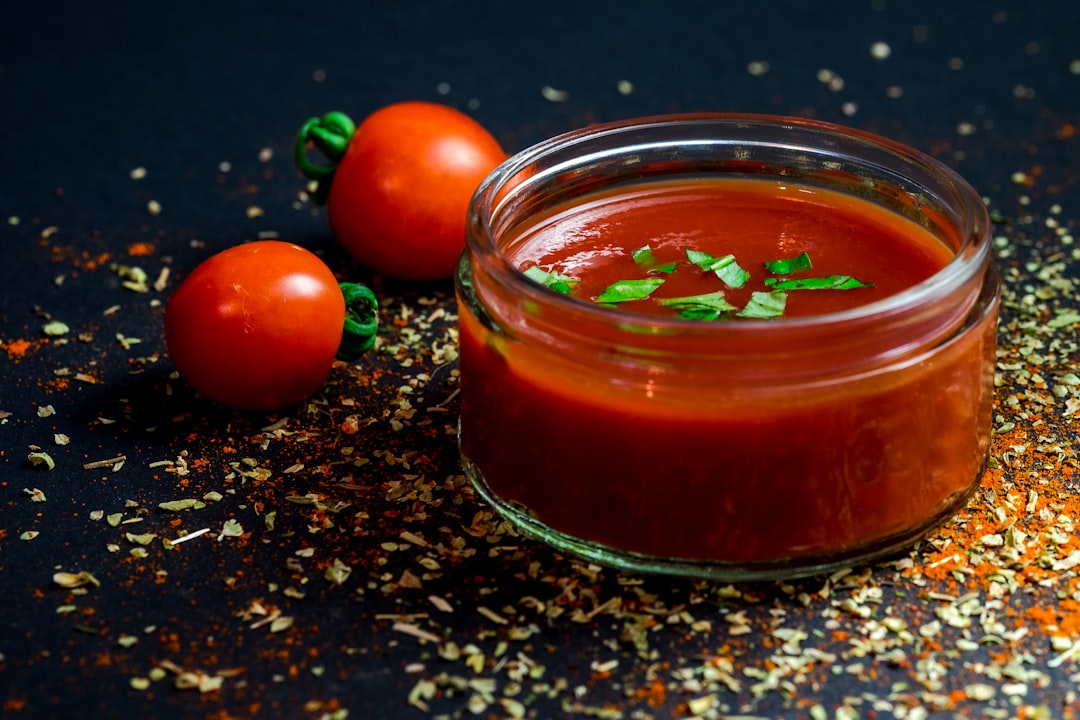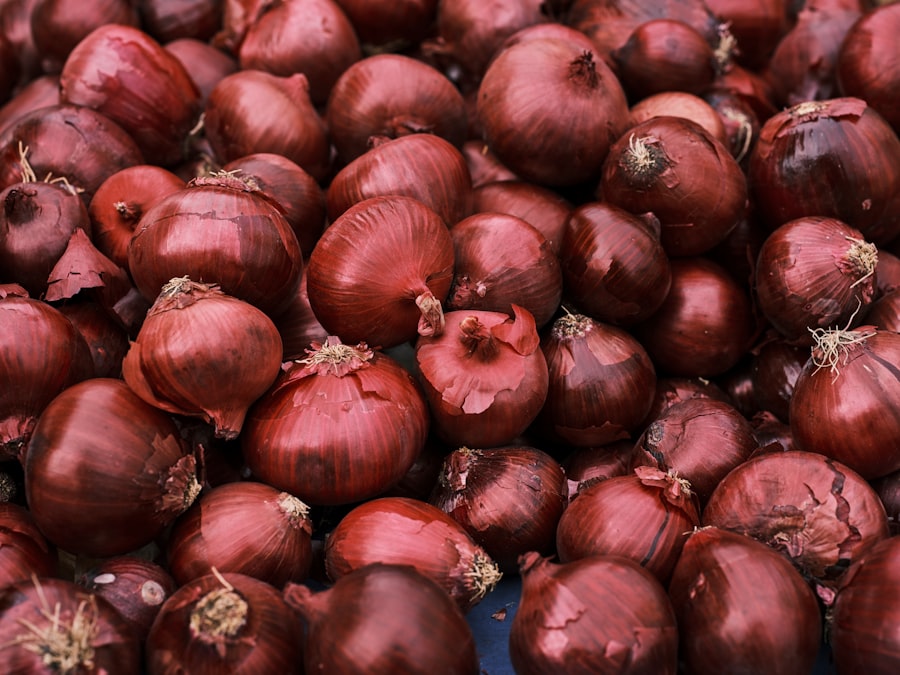Growing Red Onions: Tips for a Bountiful Harvest

Red onions are a popular vegetable known for their vibrant color and distinct flavor. They are not only delicious but also packed with health benefits. Red onions are rich in antioxidants, vitamins, and minerals, making them a nutritious addition to any diet. Growing red onions in your own garden is a great idea for several reasons. Not only will you have a fresh supply of this versatile vegetable at your fingertips, but you will also have the satisfaction of growing your own food and knowing exactly where it came from.
Key Takeaways
- Red onions are a popular and easy-to-grow vegetable that can be used in a variety of dishes.
- Choosing the right soil is crucial for growing healthy red onions, as they prefer well-draining soil with a pH between 6.0 and 7.0.
- Planting red onions involves preparing the soil, spacing the bulbs, and covering them with soil and mulch.
- Watering and fertilizing red onions regularly is important for their growth and development, but overwatering can lead to disease.
- Managing pests and diseases in red onions can be done through proper sanitation, crop rotation, and the use of organic pesticides.
Choosing the Right Soil for Red Onions
Choosing the right soil is crucial for the successful growth of red onions. Red onions thrive in well-draining soil that is rich in organic matter. The soil should have a pH level between 6.0 and 7.0, which is slightly acidic to neutral. To determine the pH level of your soil, you can use a soil testing kit or send a sample to a local agricultural extension office for analysis.
If your soil is not ideal for growing red onions, there are several ways to improve its quality. Adding organic matter such as compost or well-rotted manure can help improve drainage and fertility. Additionally, incorporating perlite or vermiculite into the soil can help improve its structure and drainage.
Steps to Planting Red Onions
Knowing when to plant red onions is essential for a successful harvest. Red onions are typically planted in early spring, as soon as the soil can be worked. Before planting, it is important to prepare the soil by removing any weeds or debris and loosening it with a garden fork or tiller.
To plant red onions, start by creating furrows or trenches in the prepared soil. The furrows should be about 1 inch deep and spaced 12-18 inches apart. Place the onion sets or transplants into the furrows, spacing them about 4-6 inches apart. Gently cover the sets or transplants with soil, making sure they are completely covered.
Watering and Fertilizing Red Onions
| Watering and Fertilizing Red Onions | Frequency | Amount | Timing |
|---|---|---|---|
| Watering | Once a week | 1 inch of water | Early morning or late evening |
| Fertilizing | Every 3-4 weeks | 1/2 cup of balanced fertilizer | After watering |
Proper watering and fertilizing are crucial for the healthy growth of red onions. Red onions require consistent moisture, but it is important not to overwater them as this can lead to rotting. Aim to keep the soil evenly moist, but not waterlogged. During dry periods, red onions may need to be watered more frequently.
Fertilizing red onions is also important for their growth and development. Before planting, it is recommended to incorporate a balanced fertilizer into the soil. Once the onions have been planted, they can be fertilized every 4-6 weeks with a nitrogen-rich fertilizer. Organic fertilizers such as compost or well-rotted manure are also suitable options for feeding red onions.
Managing Pests and Diseases in Red Onions
Red onions are susceptible to a variety of pests and diseases that can affect their growth and yield. Common pests that attack red onions include onion maggots, thrips, and aphids. These pests can be controlled by using insecticidal soaps or organic insecticides.
Diseases such as onion rot, downy mildew, and pink root can also affect red onions. To prevent these diseases, it is important to practice good sanitation in the garden by removing any infected plants or debris. Crop rotation can also help prevent the buildup of diseases in the soil.
Organic pest and disease control methods such as companion planting and using natural predators can also be effective in managing pests and diseases in red onions.
Harvesting Red Onions: When and How

Knowing when to harvest red onions is crucial for obtaining the best flavor and storage quality. Red onions are typically ready to harvest when the tops have fallen over and started to dry out. The bulbs should be firm and the outer skin should be papery.
To harvest red onions, gently loosen the soil around the bulbs with a garden fork or trowel. Carefully lift the bulbs out of the ground, taking care not to damage them. Once harvested, red onions should be cured in a warm, dry location for about 2-3 weeks to allow the outer skin to dry and harden.
Storing Red Onions for Longevity
Proper storage is important for preserving the freshness and flavor of red onions. After curing, red onions should be stored in a cool, dry place with good air circulation. They can be stored in mesh bags or hung in braids to maximize airflow.
Red onions can be stored for several months if stored properly. However, it is important to regularly check for any signs of spoilage or rot and remove any affected onions to prevent the spread of disease.
Tips for Maximizing Red Onion Yields
To maximize red onion yields, there are several tips and techniques that can be employed. One effective method is to practice companion planting. Red onions grow well with plants such as carrots, lettuce, and spinach. These companion plants can help deter pests and improve overall plant health.
Crop rotation is another important technique for maximizing yields. Avoid planting red onions in the same location year after year, as this can lead to a buildup of pests and diseases in the soil. Instead, rotate crops every year to maintain soil health and reduce the risk of problems.
Companion Plants for Red Onions
Companion planting involves growing different plants together that benefit each other in some way. When it comes to red onions, there are several companion plants that can help improve their growth and deter pests. Carrots are a great companion plant for red onions as they help repel onion flies. Lettuce and spinach also make good companions as they provide shade and help conserve moisture in the soil.
Companion planting has several benefits for red onions. It can help deter pests, improve soil fertility, and increase overall plant health. By choosing the right companion plants, you can create a balanced and harmonious garden ecosystem.
Common Mistakes to Avoid When Growing Red Onions
When growing red onions, there are several common mistakes that beginners often make. One common mistake is planting onions too close together. Red onions require adequate spacing to allow for proper bulb development. Be sure to follow the recommended spacing guidelines to ensure healthy growth.
Another common mistake is overwatering red onions. While they require consistent moisture, overwatering can lead to rotting and disease. It is important to strike a balance and provide just enough water to keep the soil evenly moist.
Lastly, neglecting to fertilize red onions can also hinder their growth. Red onions require regular feeding with a balanced fertilizer to ensure proper nutrient uptake and healthy development.
Growing red onions can be a rewarding and enjoyable experience. By following the proper steps and techniques, you can successfully grow your own supply of this versatile vegetable. From choosing the right soil to harvesting and storing, each stage of the process is important for achieving the best results. By avoiding common mistakes and implementing strategies such as companion planting and crop rotation, you can maximize yields and ensure a successful harvest. So why not give it a try? Start growing your own red onions today and enjoy the satisfaction of growing your own food.
If you’re looking to learn more about how to grow red onions, you might find this article on Lawn World’s website quite helpful. It provides a comprehensive guide on growing onions and offers valuable tips and techniques for cultivating healthy and flavorful red onions. Check out the article here to enhance your knowledge and improve your onion-growing skills.
FAQs
What are red onions?
Red onions are a type of onion with a deep purple-red skin and white flesh. They have a mild to sweet flavor and are commonly used in salads, sandwiches, and cooked dishes.
What are the benefits of growing red onions?
Growing red onions can provide a fresh supply of this flavorful and nutritious vegetable. Red onions are high in antioxidants, vitamins, and minerals, and can help boost the immune system, reduce inflammation, and improve heart health.
When is the best time to plant red onions?
Red onions are typically planted in the fall or early spring, depending on the climate. They prefer cool weather and can be planted as soon as the soil can be worked in the spring.
What type of soil do red onions need?
Red onions prefer well-drained soil that is rich in organic matter. They grow best in soil with a pH between 6.0 and 7.0.
How do you plant red onions?
Red onions can be planted from seed or from sets, which are small bulbs. They should be planted in rows, with each bulb or seed spaced about 4-6 inches apart. The bulbs or seeds should be planted about 1 inch deep.
How do you care for red onions?
Red onions require regular watering and weeding. They also benefit from a balanced fertilizer applied every few weeks. As the onions grow, they may need to be thinned to allow for proper bulb development.
When are red onions ready to harvest?
Red onions are typically ready to harvest when the tops begin to yellow and fall over. This usually occurs in late summer or early fall. The bulbs should be allowed to dry in the sun for a few days before storing.



